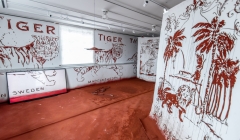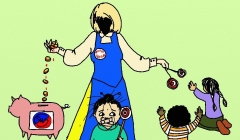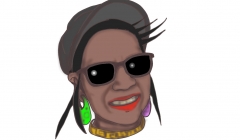On 1 February, the military in Myanmar conducted a coup to take full control of the country again, only six years after relinquishing some of its power in a democratic transition. But what they could scarcely have been expecting this time was the sheer amount of resistance they would face, from a society – and arts world – that is radically different from a decade ago. In an interview for Kultwatch, music producer and activist Lone Kavan tells us how the protests are progressing, how art can be a voice in order to challenge the junta and what might happen next.
Hi Lone. Tell us about the current situation.
– It’s really difficult to summarise. We know the SAC [the State Administration Council, the leadership of the military junta – Editor’s note] has been more aggressive than ever and has turned into a nationwide lawless, mass-killing junta. You go out on the street and protest – you get shot. You go out but just minding your own business – you get shot. You stay at home – you get shot or burned.
– Security forces have been shooting, looting, burning and throwing grenades into people’s homes – it’s definitely clear now that they’re not specifically targeting riots or demonstrators but using blunt violence against civilians. As of 29th March, they have used RPGs in major cities and launched an air strike in Karen state. In Yangon, where I am from, they have been firing guns and explosives both daytime and night time in many areas – threatening people in some townships to get out of their buildings or they’ll burn them.
– From the protestors’ side, they really don’t have enough equipment or technology. You can see even in videos many of them are wearing sandals, not having a shield or proper gear. Their weapons of choices are mainly slingshots, smoke bombs, Molotov cocktails and impromptu pipe air guns which are not reliable in terms of accuracy, range, intensity and effect. It’s obviously not equal combat on the ground.

So, what are protestors able to do? Is it still possible to organize protests despite and against such overwhelming force?
– I do think that to some extent non-violent struggle is still a viable tactic, even in the face of all this. People need to be very cautious about not losing their lives, but some things are still possible. Although it has become a bit quieter in recent days, people are still banging pots and pans around the city every night. Silent strikes are also taken place. On Easter, protestors painted Easter Eggs with slogans to show their opposition against the coup publicly. The most interesting one for me was ‘htamein’ barricades (woman’s longyi or sarong) – people hung women’s clothing up in the streets to slow down security forces from entering. Because many in our male-dominated society, especially soldiers, believe that it can lessen a man’s spiritual power if one were to pass under it.
– Another project that has been put together by audio artists is Operation Hanoi Hannah, which is a concept inspired directly from the Vietnam war. People are urged to put up Bluetooth speakers around the country to broadcast messages to demoralise the military.
What has the arts and artists been doing in terms of being part of the protest?
– I would say visual artists have been at the forefront of the artist’s movement as many of them came up with designs for posters, artwork, prints or projections which are really important in getting the message across digitally and physically (for example, sticking slogans and poster campaigns around the streets, posting artworks on social media, projecting on the walls at nights, etc.). These have been very useful in encouraging public servants to join the civil disobedience movement or raising awareness about the current issues to the public or even pushing military and police members to reflect on their own morality and decisions.
– For soldiers and police, we have seen artists posting photos of military leaders happily living in their bourgeois – high-class houses while the troops on the ground don’t even have enough funding for food. In the early days of the demonstrations, demonstrators found it effective to print General Min Aung Hlaing’s photos or paint portraits of him on the road to slow down the mobility of the soldiers (because in Myanmar culture, stepping on someone’s face is a huge disrespect and they certainly don’t want to do that to their leader). Aside from journalists and citizen journalists, filmmakers, videographers and photographers have been important in documenting or making artistic documentations of the events in Myanmar.
Can you give us some examples of music used in the protests?
– This Gen-Z music video “Doh Ayay” (Our Cause) recently went viral:
– And there are many songs people on the streets know by heart. You can hear people covering, singing these songs in almost every protest.
“Kabar Ma Kyay Buu” (Never Forget) – for fallen ‘heroes’ who fought for democracy (a reinterpreted version of “Dust in the Wind”):
“Thway Thit Sar” (Blood Bond) – a revolution anthem encouraging ‘brothers and sisters’ to resist (here in an Orchestral version):
“Alo Ma Shi” (We don’t want dictatorship) – a fairly recent song that came out during the coup:
“Revolution” – an inspirational and uplifting revolutionary piece:
In many protests around the world, social media plays a critical role. However, the junta has blocked a bunch of social media sites in Myanmar. How has that impacted your ability to organise?
– Cutting off social media has definitely interrupted the information flow, especially on Facebook (and now Instagram, Twitter, etc.) where most exchange of information takes place. People had to find ways to get access to them via VPNs. If the mobile data is cut off, a handful of people (such as journalists/activists) have been able to use Thai/Chinese SIM cards to get access to the Internet. However, wireless broadband services have already been blocked recently (only Fiber internet is officially available at the moment). Needless to say, the situation is a lot worse in some ethnic states and remote areas.
– So it’s alarming but at the same time, SAC would be digging their own graves if they plan to continue blocking the Internet for the long term as they still need to run their businesses. (For examle, Yangon Stock Exchange trading volume has already dropped by 60%.) During the first day of the coup, we couldn’t get access to the phone network at all for some time and people used some offline Bluetooth messaging apps to stay connected, but it’s not the easiest way. We can see many people are buying radios again as it’s harder to intercept radio.
– In general, cutting of social media or internet is a huge disadvantage to stay connected. However, people have been organizing protests in a decentralized way and due to current circumstances, protestors are staying within their townships/districts and organizing protests very locally with neighbours – sometimes in old-fashioned ways such as word of mouth.
For an outsider, the different groups in the Myanmar political structure can be bewildering. Can you explain what some of them are?
– The CPRH, or Committee Representing the Pyidaungsu Hluttaw, is a committee representing the parliament. It is mainly made up of members elected by the majority in the 2020 elections. These people are now in other countries or hidden in undisclosed locations around the country, forming a competing government in itself, claiming to be the legitimate government of Myanmar. On March 31st, they released a first draft of a new federal constitution, or “Federal Democracy Charter”, that protestors have been demanding. They’ve also been fundraising and have already raised over 9 million dollars as of March 31st.
– In terms of political solutions, CRPH seems to be one of the ways out. It is clear that a majority of civilians elected the current members of CRPH in the 2020 elections. Technically, we don’t have many options to choose between as an opposition government against SAC, other than CRPH. If the international community would recognize CRPH as official, there could be some potential solutions as they will be able to act as a functioning government. It’s more proactive than nothing.
– Personally, I’m a bit careful with CRPH because a majority of CRPH is made up of NLD members [former ruling party that used to be in a power sharing arrangement with the military – Editor’s note]. They’ve been trying their best but also been sloppy along the way – for example, they recently appointed Dr. Win Myat Aye as the new minister of Social Welfare. He was someone who claimed Rohingyas/Muslims burned down their own homes during 2017-2018 Rohingya crisis. This happened on top of their trust-building issues with EAOs and ethnic minorities.
Personally, I’m a bit careful with CRPH because a majority of CRPH is made up of NLD members
– EAOs – Ethnic Armed Organizations – are armed groups that represent different ethnic minorities. Many trace their roots to the fight against British and later Japanese colonialism. During the fight for Burmese independence, these minorities from different regions were promised self-administered zones in exchange for joining the fight, but after 1947 and after a military coup in 1962 all approaches towards federalism was off the table. Instead, the military government started raiding these areas.
– Some EAOs are small and some can be huge (starting from 100-200 up to around 25,000 soldiers). Some do protect their states, but some just want to keep their status quo. For a long time, the fight against the military government was like a theatre play, or like a game; for the military, especially, it was a great way to spread propaganda. It was everywhere in school when I grew up. Some of the EAOs are powers onto themselves, like the largest, the Wa Army, which also acts as a criminal enterprise growing opium poppies for heroin.
– Some EAOs are on the fence when negotiating with the CRPH because they felt like their trust was broken with NLD in the past. For instance, during the administration period, the NLD was not effective in negotiating the self-administered zones that many EAOs still see as their main aim. Now they want to wait and see how the CRPH will proceed. They know that if this revolution was a failure, the ethnic groups will be the first and most affected by the brutal junta – not the mainland Myanmar. Yet, a few members of CRPH are still focused on releasing their leaders as the main priority. If anything, civilians have made it clear that their goal is to abolish the 2008 constitution and the current armed forces organisation, release the detained leaders and form a federal union.
What do you believe will happen in the coming weeks in Myanmar?
– For the coming weeks, I can speak for Yangon – things could be relatively be calm. Because as we’ve mentioned, it’s not an equal fight – the SAC will use more brute force and unfortunately more people will die. On 27th March alone, an estimated 114 people were killed around the country. (There are 500-600 deaths in total nationwide now.) Less people will be out on the street in Yangon.
– However, this could mean a calm before the storm. We have been informed by several networks that some groups have left for the EAOs territories to obtain equipment and training. Some people, especially younger people (including youngsters I know) are starting to believe that non-violent resistance doesn’t work against the oppressive junta. They want to arm themselves and start initiating guerrilla attacks in near future. This is a likely scenario in the upcoming months.
– Personally, I think there needs to be a balance between a non-violent and possibly counter-attack solution. The CPRH forming a national government and getting international support is one way forward. I also think the military have been surprised by the civil disobedience movement – that civil servants joined freaked them out. The solution for them is just more violence, cutting off communication and information, and that may not work in preventing it.
Lone Kavan is a music producer and production designer, whose most recent work was on the feature film Money Has Four Legs, which premiered at the prestigious Busan International Film Festival – a film about censorship in Myanmar that in a stroke of irony is now in itself being censored in the new political climate. During the current protest movement, he’s been primarily working with providing safe houses, funding and topping up phone cards for journalists and civil servants who have quit as part of the civil disobedience efforts.





